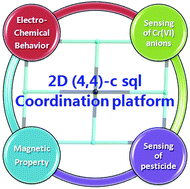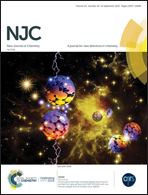Luminescence sensing, electrochemical, and magenetic properties of 2D coordination polymers based on the mixed ligands p-terphenyl-2,2′′,5′′,5′′′-tetracarboxylate acid and 1,10-phenanthroline†
Abstract
Based on the mixed ligands p-terphenyl-2,2′′,5′′,5′′′-tetracarboxylate acid (H4tptc) and 1,10-phenanthroline (phen), four novel coordination polymers, [Cu(tptc)0.5(phen)]n (1), [Cd(tptc)0.5(phen)]n (2), [Mn(tptc)0.5(phen)]n (3), and [Mn(H2tptc)(phen)]n (4), were constructed under solvothermal conditions and further characterized. Structure analyses reveal that CPs 1–4 are two-dimensional sheets with different binuclear SBUs. Moreover, electrochemical studies show that CP 1 is an electrochemically active material with good electrochemical reversibility. Luminescence sensing investigations indicate that CP 2 is a bifunctional sensor in terms of detecting Cr(VI) anions in aqueous media and 2,6-dichloro-4-nitroaniline (DCN) in DMF solution. Besides, the study on the magnetic properties of CP 3 and 4 reveals both of them have antiferromagnetic interactions between the adjacent MnII ions.



 Please wait while we load your content...
Please wait while we load your content...